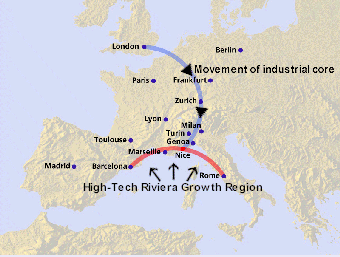Europe's Hot Banana
Europe is seeing the gradual shift of its manufacturing core southwards - the so-called 'hot banana' - from the traditional heavy industrial regions of the north-west towards the Mediterranean. Catalonia is now the first choice destination for new multinational investments in the European Union Euro zone. With it is coming a spread southwards of high technology clusters, particularly along the Mediterranean Riviera, with the Sophia Antipolis Science Park near Nice being the pioneer in the field. Barcelona, with its high-tech cluster in El Vallès chosen as the location for southern Europe's new generation particle accelerator, is poised to become a key Mediterranean high-tech growth pole.
|
|
| Changing location of industry: Europe's 'hot banana' |
The United Kingdom and Ireland up to now have won Europe's lion's share of US high-tech investments but all European governments have now got in on the act, dangling incentives to attract high-tech industries that are proving to be a lifeline for regions that are losing their competitive edge.
Europe has not created anything to rival Silicon valley in California yet. Income disparities across the regions of the European Union are much wider than across the United States, leading to high-tech clusters in Europe developing in a wide range of environmentally-attractive low labour cost locations. Despite the single market for goods and labour and large intra-country wage differences, there is still very little migration across countries: only 1.5% of EU citizens live in a member state other than the one in which they were born. This contrasts with the high mobility of US workers.
If labour does not move, it will be firms that move. Firms in labour intensive sectors in Europe are increasingly relocating to the regions where factors that cannot be easily transported (notably labour) cost less. Barcelona is such a low-cost but accessible peripheral location and has many advantages not shared by competing areas such as Walldorf, Espoo, Newbury or Berlin.
Source: London continues to be the region of the European Union with the greatest capacity to attract multinational investment, according to a report published 11.04.2002 by auditor Ernst & Young. But those projects fell by 50% in 2001. Catalonia, on the contrary, is stepping on London's heels after leaping over the region of Ile-of-France (Paris) to take second place in the new projects ranking. According to the latest report of the Monitor of European Investments (www.ey.com), there was a 12% fall in the number of new project investments in the EU, that includes manufacturing, pharmaceuticals, financial services and research and development. The reduction is due to a 26% fall in investments coming from the U.S.A.. This fall has hit the United Kingdom and France hard. Both are main receivers of investments from multinationals locating in the EU. The Irish economic miracle, based on the capacity of the Celtic "tiger" to attract American investments, is in a state of collapse after a fall of 46% in new investments in the country. Spain and Germany, with few employees of American multinationals, have been left almost undamaged by the crisis. Catalonia's 4.4% share of new investments puts it in second place. Madrid has seen a 50% increase in foreign investments, although the Spanish capital lies eight places below Catalonia in the ranking. Catalonia's share of projects has risen from 1.6% in 1998 to 4.4% in 2001. In spite of the fears that the new competition coming from East Europe has been able to decrease the attractiveness of the countries of the south of the EU as manufacturing bases, Ernst & Young emphasize another tendency: "the new manufacturing investments are moving towards the east and the south, with an increase in the popularity of destinations such as Czech Republic, Hungary, Portugal, Rumania, Spain and Turkey". Catalonia, and the Czech regions of Stredocesky and Zapadocesky share the majority of the new investments in the motor industry. Six of the ten automobile components projects went to East Europe, three of them to Czech Republic. On the contrary, Hungary and Poland have lost attraction for the automobile industry and have seen a reduction in their share of investments in this sector from 12% to 4%. Catalonia, Alsace and Moscow "are the strongest regions in this sector, assures Ernst & Young. Catalonia also appears in the group of regions that have caught more investments in research and development.

